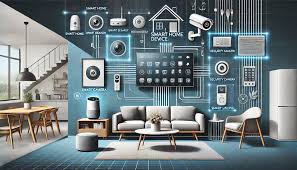United States Smart Home Market Analysis
The United States Smart Home Market is poised for significant growth, with the market size expected to surpass US$ 87.25 billion by 2032, up from US$ 31.85 billion in 2023, representing a robust CAGR of 11.85% from 2024 to 2032. This expansion is driven by several factors, including rapid advancements in technology, the growing adoption of smartphones and high-speed internet, as well as a heightened focus on energy efficiency and home automation. Furthermore, the convergence of artificial intelligence (AI) and the Internet of Things (IoT) is revolutionizing the way smart home’s function, creating significant market opportunities.
Request a free sample copy of the report: https://www.renub.com/united-states-smart-home-market-p.php
United States Smart Home Market Outlook
A smart home refers to a residence equipped with interconnected devices and systems that can be remotely monitored and controlled. These homes utilize various home automation systems that may include security features, lighting, climate control, and entertainment systems, all connected through the internet and controlled via smartphones or web portals. The main difference between basic home automation and smart homes is the degree of integration, where smart homes are often equipped with devices that interact and optimize their functions in real-time using AI and machine learning algorithms.
Over the next decade, the United States Smart Home Market is expected to experience significant growth, driven by increasing demand for both security systems and energy-efficient solutions. Consumers are increasingly seeking ways to enhance the convenience, comfort, and safety of their homes while reducing their environmental footprint. As wireless technologies continue to evolve, homeowners are increasingly integrating smart devices like HVAC controllers, entertainment systems, and security regulators, all powered by IoT-enabled technology.
Key Drivers of the U.S. Smart Home Market
1. Technological Advancements in AI and IoT
One of the key factors propelling the U.S. smart home market is the continuous development of artificial intelligence (AI) and Internet of Things (IoT) technologies. These innovations allow for seamless communication between devices and systems, enabling users to control and monitor their homes remotely. AI-powered systems are able to learn and adapt to users’ preferences, creating a personalized and more efficient living environment. For instance, smart thermostats can adjust the temperature based on user behavior, and smart lighting systems can change intensity and color according to the time of day.
The rise of machine learning (ML) algorithms allows devices to continuously improve their functionality, creating smarter and more efficient homes. In addition, technologies like biometric identification, facial recognition, and AI-driven threat detection are enhancing home security, further driving consumer demand for connected devices.
2. Increased Demand for Fast and Reliable Internet
The availability and accessibility of high-speed internet are critical factors influencing the growth of the smart home market. With the growing adoption of smartphones and smart devices, consumers need fast, reliable internet connections to enable the seamless operation of their smart homes. High-speed internet such as broadband, 4G, and 5G networks provide the infrastructure necessary for real-time communication between smart devices, ensuring that homeowners can control their devices from anywhere in the world.
Smart home systems rely on constant connectivity to allow users to manage lighting, temperature, security, and entertainment systems through apps or voice commands. The integration of cloud computing and big data also enables smart home devices to provide real-time notifications, updates, and remote troubleshooting, further enhancing the user experience.
3. Energy Efficiency and Environmental Sustainability
As consumers become more conscious of their environmental impact, the demand for energy-efficient smart home solutions has grown. Smart thermostats, lighting, and appliances are designed to optimize energy consumption, which not only helps homeowners save on utility bills but also reduces their carbon footprint. For example, smart thermostats like Nest or Ecobee can learn the user’s routine and adjust temperatures automatically, resulting in a more energy-efficient home.
Moreover, advancements in solar technology, smart grids, and energy storage solutions are contributing to the growth of the smart home market. These solutions allow homeowners to monitor and manage energy use more effectively, contributing to a more sustainable lifestyle.
4. Growing Consumer Awareness and Demand for Convenience
Consumers are becoming more aware of the convenience that smart home technologies offer. Voice assistants like Amazon Alexa, Google Assistant, and Apple Siri are allowing users to control everything from lights and locks to thermostats and entertainment systems with a simple voice command. This growing demand for convenience is fueling the adoption of smart home devices across the U.S. market.
Additionally, the millennial generation, which is highly tech-savvy, is increasingly driving demand for smart home devices. These consumers are more likely to invest in technology that enhances the convenience, security, and efficiency of their homes, which is leading to widespread adoption of connected home devices.
Florida Smart Home Market
The Florida Smart Home Market has seen rapid growth, particularly due to the state’s warm climate, which makes smart thermostats and energy-efficient cooling systems particularly attractive to homeowners. Florida is a hub for smart home technology adoption, with many residents turning to home automation for energy savings, security, and overall convenience. Given Florida’s unique environmental factors, smart thermostats that can adjust temperature settings based on weather conditions and occupancy patterns are in high demand.
The state’s real estate market has also embraced smart home technologies, with developers incorporating connected devices into new homes to attract potential buyers. High-net-worth individuals in areas like Miami and West Palm Beach are particularly inclined to invest in advanced smart home solutions, elevating the demand for personalized and luxury smart home designs. In fact, there has been a significant surge in home sales in Florida, particularly in the luxury real estate segment, further driving the need for integrated smart home systems.
Key Factors Driving Florida’s Market:
- Warm climate driving demand for smart thermostats and energy-efficient systems.
- Real estate growth leading to increased incorporation of smart home technologies in newly built homes.
- High-net-worth individuals demanding custom, high-end smart home solutions.
- Growing awareness of the benefits of home automation and security in Florida’s large urban areas.
Leading Companies in the U.S. Smart Home Market
The U.S. smart home market is highly competitive, with many leading companies driving innovation and product development. Some of the top players include:
- Panasonic Corporation
- Sony Corporation
- Samsung
- Apple Inc.
- Schneider Electric
- Amazon.com Inc.
- Honeywell International Inc.
These companies are at the forefront of creating new smart home solutions, from security cameras and voice-controlled assistants to energy management systems and home automation hubs. Their investments in R&D, as well as their partnerships with homebuilders and other industry leaders, are shaping the future of the smart home industry.
Recent Developments in the U.S. Smart Home Market
- Amazon (November 2022):
Amazon unveiled new WWA certification guidelines for Matter devices, enabling more seamless integration of smart home products from different manufacturers. This standardization improves the compatibility and reliability of smart home systems, making it easier for consumers to set up and manage their devices.
- Roku Inc. (October 2022):
Roku expanded its smart home product line, introducing a variety of new devices, including video doorbells, security cameras, smart plugs, and lighting solutions. This moves significantly broadened Roku’s smart home ecosystem, catering to households looking for easy-to-use, affordable devices.
- Google (October 2022):
Google’s Nest Wifi Pro introduced Wi-Fi 6E and a range of smart home upgrades, including a wired doorbell and an enhanced version of the Google Home app. This new setup allows for faster internet speeds, more reliable device connectivity, and better overall home automation performance.
Related Report :
United Kingdom E-Commerce Payment Market
Germany E-Commerce Payment Market
About the Company:
Renub Research is a Market Research and Consulting Company. We have more than 15 years of experience especially in international Business-to-Business Researches, Surveys and Consulting. We provide a wide range of business research solutions that helps companies in making better business decisions. We partner with clients in all sectors and regions to identify their highest-value opportunities, address their most critical challenges, and transform their businesses. Our wide clientele comprises major players in Healthcare, Travel and Tourism, Food Beverages, Power Energy, Information Technology, Telecom Internet, Chemical, Logistics Automotive, Consumer Goods Retail, Building, and Construction, Agriculture. Our core team is comprised of experienced people holding graduate, postgraduate, and Ph.D. degrees in Finance, Marketing, Human Resource, Bio-Technology, Medicine, Information Technology, Environmental Science, and many more.
Media Contact:
Company Name: Renub Research
Contact Person: Rajat Gupta, Marketing Manager
Phone No: +91-120-421-9822 (IND) | +1-478-202-3244 (USA)
Email: mailto:rajat@renub.com



